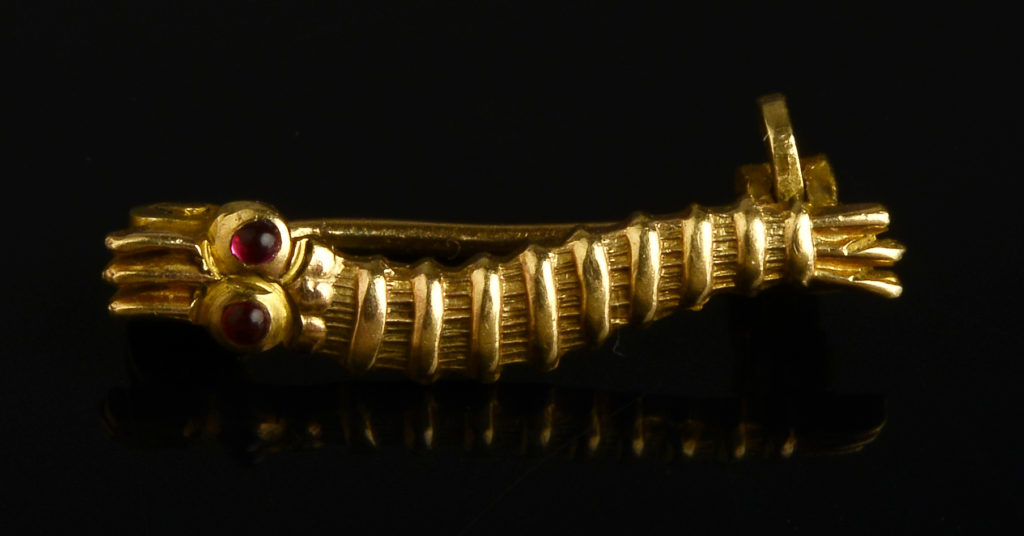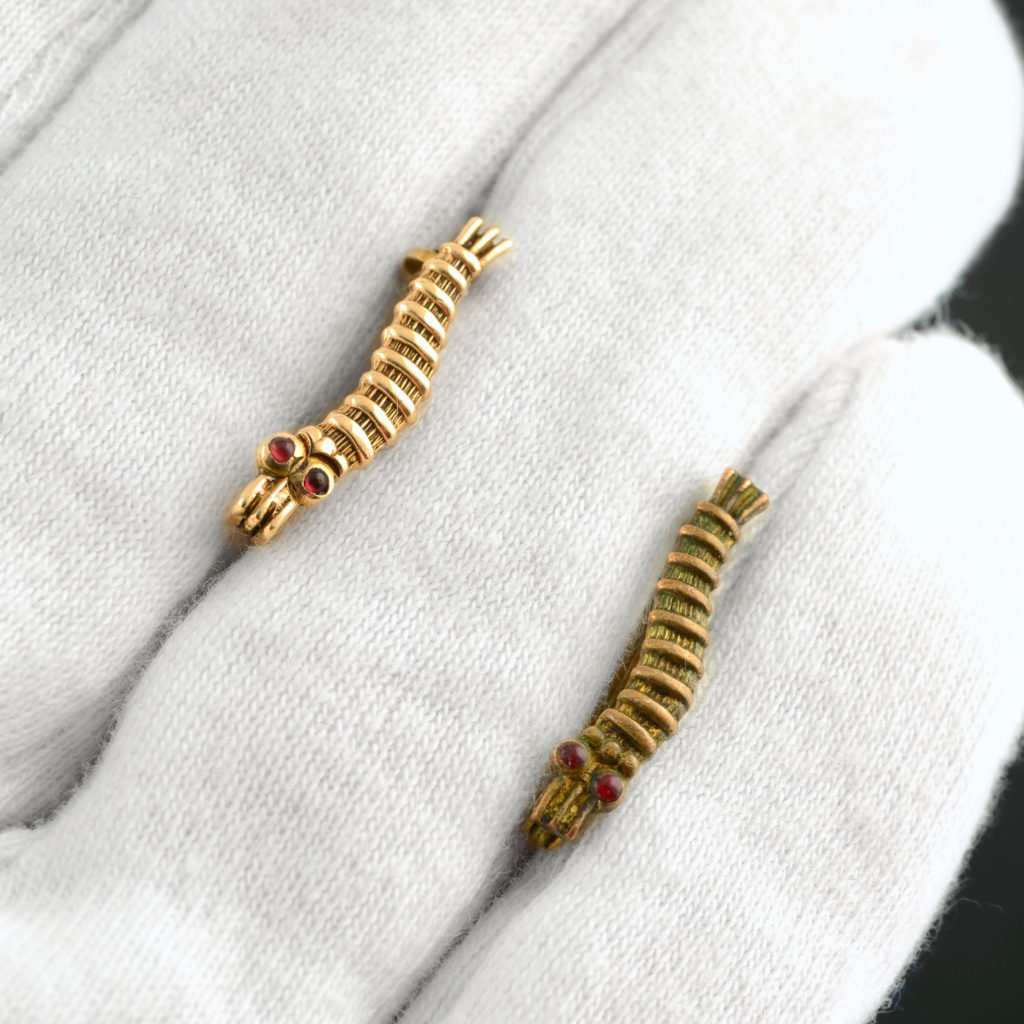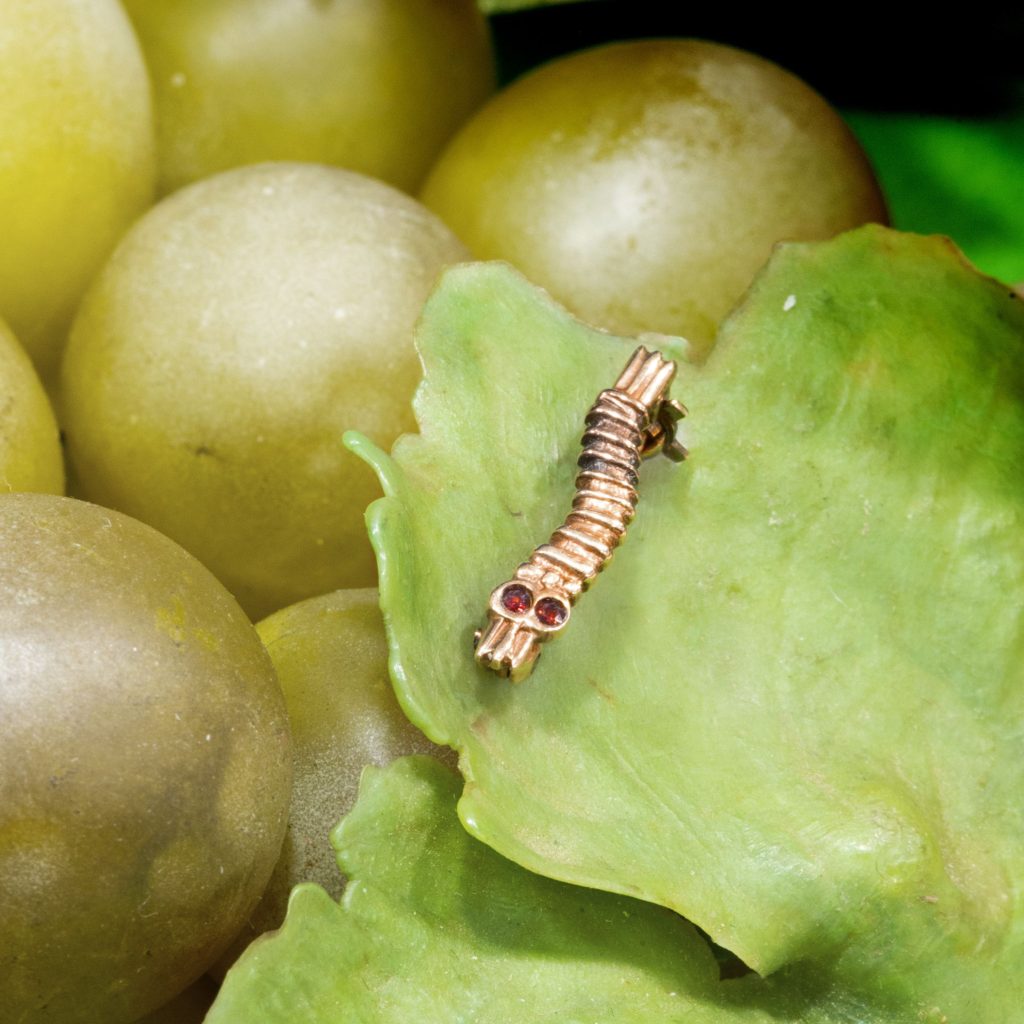Caterpillar Club brooches – insignia of the club that no one wants to join.
Caterpillar Club History
It is hard to find a fully corroborated account of who founded this mysterious club. The basis remains the same. After hearing about a test pilot who was saved by his parachute during a failed test in 1922, an idea was formed. Maurice Hutton and Verne Timmerman (reporter and photographer for the Dayton Herald) and H. H. St. Clair ( a parachute engineer for the USA government) founded the club to recognise those airmen who had been saved by parachutes. While some reports say that Leslie Irvin of Irvin Air Chutes was involved from the beginning, there is little documentation about how the club came to be. To this day, it doesn’t have any official website, officers, or chapters.
What we do know is that in 1926, the Irvin Air Chute Co. (now known as IrvinGQ) started issuing membership cards and golden caterpillar pins to those who had used their parachutes to escape from a disabled aircraft.
Over the years, there have been three Caterpillar Clubs from different parachute companies- Irvin, Switlik and Pioneer. Of these three, only the Irvin and Switlik clubs remain.
Club Membership
IrvinGQ has reported that by 1939, membership of the Caterpillar Club had risen to 4,000 and included people from all over the world. This number increased at an extreme rate during the Second World War. The company now estimates that the lives of at least 100,000 people have been saved by an Irvin parachute.
Interestingly, other clubs of this nature popped up during WWII. The Late Arrivals Club awarded its members a pin showing a boot with wings. This was to pay homage to the servicemen who bailed out of an aircraft behind enemy lines and walked back to safety. The Goldfish Club commemorated people who parachuted out over the water and relied on a dinghy for survival. It took inspiration from the Caterpillar Club and had as its sponsor P B Cow and Company of Farnborough who manufactured rubber aircraft survival dinghies, as well as other manufacturers of rescue dinghies. The Australian War Memorial website gives a lot more information on these clubs, as well as others.
A History of The Caterpillar Club
Caterpillar Club Brooches
How to Join the Club
A Caterpillar Club brooch (or pin) is literally a badge of honour for pilots who have been in the precarious situation of their aircraft going down. It is a testament to the aviator’s bravery and quick thinking during a dangerous situation. The Irvin website says that the only requirement to join is to have saved one’s life by an Irvin (IrvinGQ) parachute from a stricken aircraft. The club allows applications from both civilian and military personnel may apply. The exception here is that anyone who intentionally jumps from an aircraft may not apply. e.g. skydivers or parachutists. Anyone who does apply to become a member will need to give supporting evidence which Irwin will then verify.
Irvin does not charge for the membership application, nor for the gold brooches.
Design
The Caterpillar Club brooches, also known as pins, are distinctive pieces of jewellery which immediately identify the wearer as belonging to this rare and mysterious club. Unsurprisingly, those who have earned them, value them highly.
The IrvinGQ Caterpillar Club pins are gold in colour with red eyes. Reports vary as to the materials used in the production of this iconic pin. At Fellows, we have seen brooches with bodies made from solid gold or gilt; with eyes made from garnets or red enamel. We have found historic newspaper reports which mention eyes made from amethysts. However, we have never seen any such items through our auctions.
The caterpillar brooch is three-dimensional with ridges along the back. It is styled to depict the insect’s natural form. The design makes the viewer think of the movement of the animal and is quite realistic. To the reverse of the brooch, you will find an inscription of the recipient’s name, and sometimes rank where appropriate. The pin itself is extremely small, which makes the level of detail even more impressive. It is less than 2cm long and weighs less than 1g.
The Switlik Parachute Company has its own design. The silver brooches feature black enamel in the design of a caterpillar. In the black enamel, you can read the words “CATERPILLAR CLUB” in white relief on the front. This design does not tend to have inscriptions on the reverse.
While there have been a few different designs and issuers of these types of pins over the years, The Irvin Caterpillar Club brooches are by far the most prevalent.
The Mystery of Two Caterpillar Club Brooches
In an auction in May 2023, we have for sale a pretty intriguing lot. This lot features two Caterpillar Club brooches, both awarded to the same man. One brooch is solid gold with red garnets for eyes; the other is base metal with red enamelled eyes. You can find out about Flight Officer Stead’s amazing story on our blog.
The mystery of this lot is: why did one person have two brooches?
Theory one:
He was in the unenviable position of needing to be saved by a parachute twice.
We can disregard this theory on two counts. Firstly, there is no mention of any other incident where Stead was involved in a life-saving parachute incident. Secondly, we have spoken to historians and Irvin themselves who have said that once a member has been inducted into the club, they do not receive another pin.
Theory two:
Stead lost his brooch and the second one is a replacement.
When we spoke to Irvin, they did not have any record of a replacement being requested or issued. Their records are very detailed.
Theory three:
The base metal brooch was for everyday wear; the gold one was for formal occasions and mess dress.
We can’t find any supporting documentation for this theory or for RAF officers being given leave to adorn their uniforms with Caterpillar Club brooches.
Theory four:
Gold brooches were not awarded at the time.
This is the theory that holds the most water at Fellows HQ, for a number of reasons.
Firstly, due to the supply and manufacturing issues of the Second World War, the production of non-essential jewellery was prohibited during the 1940s. This gave rise to the introduction of the utility mark on wedding rings in the 1940s. Given the fact that these brooches were not essential items like wedding rings or even identification bracelets and cufflinks, they would not have been able to be produced under license in the UK.
We know this was a consideration for people applying to join the club from this clipping from a 1944 memo from the records of the 96th Bomb Group (US Army Air Corps) which specifically singles out the situation in the UK.
We also have to take into account that, although the event that would have allowed Stead to become a member of the club took place in 1943, he was a prisoner of war until 1945. While it is possible that he could have applied for and received the brooch while in prison (see the example of Rolex sending watches to prisoners during WWII), a piece of gold jewellery may not have made it to him there.
While we may never know why this particular person had two brooches, it is fascinating to speculate and dig into the history of such a prestigious group of people. If you have any information or different theories, please send us an email to hello@fellows.co.uk
Caterpillar Club Brooches at Auction
We have had the privilege of selling a few Caterpillar Club brooches over the years. Why not take a look at some of the stories associated with these pieces of history?
A 9ct gold Irvin Caterpillar club pin awarded to Sgt Bernard John Warren 1851650, 103 sqn. On 23rd April 1944 from Elsham Wolds he was aboard a Lancaster III. They were hit by flak and Warren baled out of the aircraft using a parachute. He was taken prisoner at Stalag 357 Kopernikus. Read more.
Sold for £1,170.00 (including fees) April 2024.


Awarded to Flight Sargent Stanley Cranston Alldis, 57 Sqdn, while he was a bomb aimer aboard an Avro Lancaster Mk 1 11th November 1944. He was taken prison and held at Stalag Luft L7 Bankau.
Sold for £1,365 (including fees) January 2024.
Awarded to P/O C E Stead during an incident with a Lancaster Bomber on 3rd/4th of November 1943.
Sold for £2795 (including fees) in May 2023.


Awarded to Sgt. W. H. T. Farmer of the RAF due to an incident involving a Spitfire on 23rd July 1942. Sold for £2,169.20 (including fees) May 2022.
Awarded to Sgt Frederick Gordon Spanner of the Royal Canadian Air Force (RCAF). He received several medals during his career including the Distinguished Flying Cross.
Sold for £1,173.92 (including fees) April 2019.


Awarded to Sgt. M. Skubiszewski.
Sold for £1,531.20 (including fees) in November 2017.
Valuations
Our valuations are free, with no obligation to sell with us. Our experts will value your item with an estimate, so you can find out what it could achieve at auction.
The process is simple. You can fill in a form online or book an appointment to visit either of our offices in Birmingham or London. Virtual valuation appointments are also available.
Find what you’re looking for
Make sure you don’t miss finding that special something by signing up to our email alerts. You’ll be the first to know when catalogues become available, receive invitations to special events and preview the hottest lots from our auctions, plus much more.
Why not use our free personal shopping service? Sign up for lot alerts and tell us exactly what you are looking for. Each time we upload a catalogue, we search for your keywords and email you lots matching your interests. Your personalised email will include images, lot descriptions and auction details.
Alexandra Whittaker BA (Hons) | Head of Partnerships and Events



